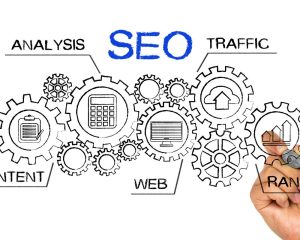Some things we want to be slow – like walks on the beach and sunsets. Then there are those things that are not really worth the time unless they are fast. We are thinking roller coasters and race cars here. Did you know that your website belongs in the fast site speed category? It should load as fast as possible for maximum SEO advantage.
The question for you is this: is your site fast enough? Trust us when we say speed is important. If your site is too slow, it could be chasing away visitors and negatively impacting search engine rankings. In this day and age, there just is no room for websites that take too long to load.
Google Ranks for Site Speed
Speed matters to SEO for the simple fact that search engines consider it a ranking factor. Google is believed to be the first one to do it, having adjusted their algorithms to account for site speed as far back as 2010. An update in 2018 combined speed with mobile friendliness, making it even more important for your site’s pages to load quickly.
If all other things are equal, Google will rank the faster of two pages higher. Do not underestimate the importance of speed. Fortunately, there are lots of things we can do to increase site speed. And with Google’s latest algorithm updates, much of what we do to speed up pages centers around something known as rendering.
Rendering and Its Relation to Speed
Modern web pages are presented to search engine crawlers in two formats. First is the raw code that can be crawled, indexed, and ranked extremely quickly. It takes crawlers mere seconds to scan and index even the largest websites. Moreover, indexing is still the preferred method for understanding web pages and ranking them accordingly.
Rendering goes beyond indexing. Rendering seeks to understand what a website actually looks like to users. Where indexing concentrates on what’s under the hood, rendering is more about what is visibly seen. Rendering is all about what we call the user experience (UX).
Google has been quietly working to improve its rendering engines over the years. Where it used to take days or weeks for a web page to get through the rendering queue, it can now get through Google’s queue in about five seconds. There is no guarantee, as some pages can still get stuck in the queue for days or weeks, but the median is five seconds.
How does this relate to speed? If Google’s headless browser can render a page in under five seconds, so can yours. Google likes that. The faster it can render your pages, the better your pages will rank in combination with other SEO factors. It is no more complicated than that.
Rendering and User Experience
There is a reason Google, Bing, and the other search engines consider speed as important as they do. That reason is user experience. You know yourself how annoying it is to sit around and wait for pages that take too long to load. If you have to wait more than five or six seconds, you are likely to click the back button and find some other link to follow.
Search engines know this. They also know that they limit their own revenues if they rank pages people don’t want to visit high on their SERPs. So they just don’t. They strive to serve up those results that will get the best response for a given search. Speed plays into that inasmuch as users want fast websites.
Rendering essentially gives Google’s computers an opportunity to simulate the user experience and then include the resulting data in the ranking analysis. If their computers simulate a poor user experience, it is a safe bet that real users will have a poor experience as well.
How We Speed up Load Times
There are rumors that rendering will eventually displace indexing entirely. Google and its competitors certainly appear to be moving in that direction, constantly updating their algorithms to make better use of rendering data. Smart SEO developers assume rendering will continue to play a more important role, thereby adjusting their strategies to account for it.
We keep rendering in mind when we deploy strategies to speed up load times. We are happy to say there is no shortage of strategies we can turn to. Below are just some of the things we can do to make your website faster.
1. Optimize Your Images
Loading images is the primary speed killer on modern websites. Why? Because high-res images, as attractive as they are, take a comparatively long time to load. We change the dynamic by optimizing images for faster load times. Optimization strategies include controlling resolution, image size, and the number of images on a given page.
As an example, it is common to find websites with large image files that have to be scaled down by a browser in order to be viewable. It makes no sense to upload image files that are bigger than required for the page at hand. Such images have to be resized by the browser, which takes time. So instead, we resize images so that the browser doesn’t have to. That instantly saves time.
Image compression is something else we do. Compression is a process of reducing a file’s size by removing unnecessary data. Compressed images load faster because browsers are dealing with less data.
2. Reduce File Size
Your typical website offers a variety of different files to be served to browsers upon request. They include CSS, HTML, and JavaScript files. Like images, these files often contain unnecessary data. Eliminating that data reduces file size and increases speed.
We human beings appreciate text formatting because it’s easier on the eyes. It is easier for us to read documents when there are spaces between the paragraphs, bold and italicized text, etc. Computers don’t care about formatting. Just by removing all of that unnecessary stuff from raw code, we can reduce file size by quite a bit.
3. Reduce Server Requests
Every element on a web page requires a browser to make a request of the server. These are known as HTTP requests. The fewer requests, the faster the page. We can speed up page load times by reducing the number of requests a browser makes to the server.
One way to do this is to simplify. In other words, we try to limit things like images and scripts to only what is necessary for a given page. Superfluous elements are limited as often as possible. Additionally, we can tweak a website’s user interface (UI) to get rid of unnecessary elements without negatively impacting UX.
4. Lazy Loading
One of the more recent strategies the SEO industry has come up with is something known as lazy loading. Lazy loading is a concept based on the idea of on-demand loading. In other words, there is no need to immediately load those elements that cannot be seen in a single screen view. Just load whatever is necessary to correctly render the immediate view.
As the user scrolls through the page, new elements are loaded in real time. The elements above that point are not dumped; they are cached instead. The end result is a page that loads in stages as the need arises. In terms of Google’s rendering queue, lazy loading has a tendency to push pages through the queue faster for the simple fact that Google’s headless browser doesn’t have to load as much data.
Let’s Make Your Site Speed Faster
Google has been ranking site speed for a decade. However, continually improving their rendering engine is making speed more important every day. The simple fact is that your site needs to be as fast as possible if you want to satisfy both search engines and your visitors. Speed is both a search engine ranking factor and a critical component of the user experience.
Here at WebTek, we have a need for speed. We are ready to get to work for you; ready to work with you to make your website faster. Contact us to learn more about our SEO and web development services. Whether you have an existing website or are starting from scratch, we employ all the latest design techniques and white hat SEO practices to create sites that get results.















